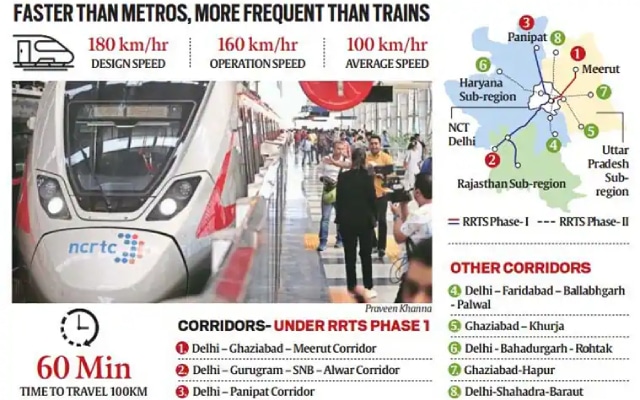New Delhi: On October 20, 2023, Prime Minister Narendra Modi inaugurated the first phase of India’s Regional Rapid Transit System (RRTS). This groundbreaking transportation system is designed to enhance regional connectivity and offer swift travel options to commuters. In this article, we delve into the RRTS project, its significance, and how it can benefit the National Capital Region (NCR).
Understanding the RRTS Project
The Regional Rapid Transit System (RRTS) is a state-of-the-art mass transit network that revolves around semi high-speed rail connectivity. The primary goal of the RRTS is to foster balanced and sustainable urban development by providing superior connectivity throughout the NCR.
Origins of the RRTS Project
The concept of the RRTS stems from a study commissioned by the Indian Railways in 1998-99. This study explored the feasibility of an RRTS network connecting various locations in the NCR through high-speed commuter trains. The proposal gained traction in 2006 as the Delhi Metro expanded its reach to NCR towns like Gurgaon, Noida, and Ghaziabad.
The National Capital Region Planning Board (NCRPB) took the lead in further developing the project. The NCRPB identified eight RRTS corridors to establish high-speed rail-based commuter transit services, thereby linking NCR towns more efficiently.
Creation of the RRTS – Namo Bharat
The implementation of the RRTS project was carried out by the National Capital Region Transport Corporation (NCRTC), a joint venture involving the Central government and the states of Delhi, Haryana, Rajasthan, and Uttar Pradesh. This initiative, known as “Namo Bharat,” is managed by the Ministry of Housing and Urban Affairs. Covering an extensive area of approximately 55,000 square kilometers and home to over 46 crore residents with a combined GDP of $370 billion, the NCR is the focal point of the RRTS project.
What Sets RRTS Apart
The RRTS differentiates itself from existing metro and railway systems by offering a unique combination of speed and comfort. It aims to cater to commuters seeking to travel longer distances across the NCR in a shorter period. While covering smaller distances than the Indian Railways, RRTS trains will operate at higher frequencies and provide a more comfortable travel experience than conventional railway coaches. This model is inspired by successful rail systems like the RER in Paris, Regional-Express trains in Germany and Austria, and the SEPTA Regional Rail in the United States.
Goals of the RRTS Project
The RRTS project holds several objectives. It aims to unlock the full potential of the NCR by enhancing multi-modal connectivity at existing transportation hubs. By promoting public transportation, it seeks to alleviate congestion on roads, highways, and existing metro and railway networks. Economically, the project is expected to generate employment and stimulate the development of new commercial hubs within the NCR. This allows residents in suburban areas surrounding Delhi to participate in the capital’s economic activities without relocating, increasing economic productivity across the region.
Impressive Speed of RRTS Trains
RRTS trains are designed for high-speed travel, offering a significant advantage over metro trains. These trains can reach speeds of up to 160 km/hour and are capable of running even faster, up to 180 km/hour. In contrast, Delhi Metro trains typically operate at speeds ranging from 100 km/hour to 120 km/hour, depending on the line.
Upcoming RRTS Corridors
The RRTS project will encompass eight corridors in total. Phase I includes the following corridors: Delhi-Ghaziabad-Meerut (82 km), Delhi-Gurugram-SNB-Alwar (164 km), and Delhi-Panipat (103 km). Future corridors to be developed include Delhi-Faridabad-Ballabgarh-Palwal, Ghaziabad-Khurja, Delhi-Bahadurgarh-Rohtak, Ghaziabad-Hapur, and Delhi-Shahadra-Baraut. Sarai Kale Khan station will serve as the central hub for all three Phase I corridors, connecting the NCR to Uttar Pradesh, Haryana, and Rajasthan.
Inaugurating the ‘Priority Section’
During the inauguration, Prime Minister Modi opened a 17-kilometer stretch recognized as the ‘priority section’ of the 82-kilometer Delhi-Ghaziabad-Meerut RRTS corridor. This segment comprises 16 stations, with five in the priority section: Sahibabad, Ghaziabad, Guldhar, Duhai, and Duhai Depot. The full corridor is anticipated to become operational by 2025.
Conclusion
The launch of the Regional Rapid Transit System (RRTS) is a significant step towards enhancing regional connectivity and streamlining transportation in the National Capital Region (NCR). With its high-speed trains and comprehensive network, the RRTS is set to transform the way commuters travel across the NCR, fostering sustainable urban development and economic growth.




